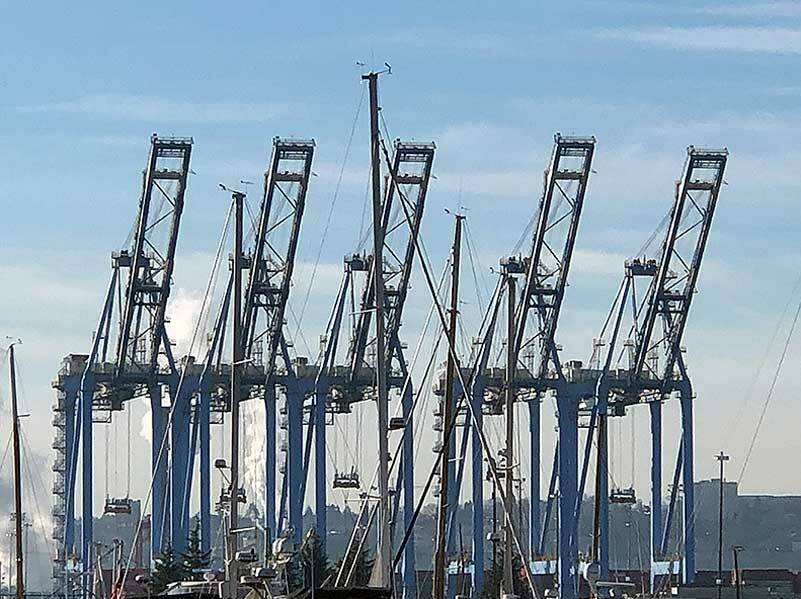By Morf Morford
Tacoma Daily Index
If there is anything we in the greater Tacoma area know on a more visceral level than most parts of the country, or even the world, it is that events thousands of miles away, in countries many of us have barely heard of just might have a dramatic impact on our local economies.
Whether it is apples or microchips, our global economy – with hundreds of local repercussions seeps into all kinds of unexpected corners of our lives.
From job security to the price of gas at the pumps to whether kids go to school, what happens in, or emerges from, some distant corner of the world might hit us in ways we never would have expected.
To some degree this has always been true – it just took longer. A plague, or even a juicy rumor, or sometimes the beginning or ending of a war, could have taken months when it might take a matter of hours or possibly a day or two at most now.
21st Century Supply Chains
Supply chains have always been about more than material objects. Besides food and machine parts, supply chains, trade routes and shipping lanes, for millennia, have been the platform for ideas, literacy, cultural change and revolution.
Port cities, like Rome, Paris, London, New York City, San Francisco, Liverpool, and yes, Seattle and Tacoma have an outsized influence on the history and culture, and economy compared to outlying areas.
Everything from music to drinks of choice (like coffee or tea) to foods or fashions hits the port cities first.
And when catastrophes, form wars to hurricanes, port cities act – or are the central points for relief or shipping of everything from food aid to military equipment. And, of course, people immigrating, emigrating, escaping or avoiding captivity or trouble.
You might think of international affairs as the domain of politicians, or military leaders or even diplomacy, but the bottom line is that much, if not most, of the actual work of a global economy – from the delivery of fuel to holiday gifts and decorations to automobiles – and much more – depends on our ports.
Looking back and looking forward
Port cities are often the oldest, and most foundational cities of a region – but they are often also the newest and most innovative and forward-thinking.
Ports facilitate movement of agricultural products, raw material and finished products.
Ports embrace and embody their own resources and identity even as they interact with cultures, languages and traditions very different from themselves.
Few entities express a community’s identity, history and purpose better than the local port.
Based on the fortuitous convergence of geography, human industry and local natural resources, ports, for better or worse, become a base for trade and commerce – often for centuries.
Port of Shanghai
A good example of this is the Port of Shanghai. It is the largest seaport in the world, and opened for international trade in 1842.
Before that, the Port of Shanghai has a long and rich history dating back to the Qing dynasty in the 16th century. At least. The surrounding host city was authorized in 1297 by the Yuan Dynasty.
In 1684, ocean-going vessels were allowed to use the port courtesy of the Quin Dynasty, which helped the port to collect customs duty for all foreign trade and by 1735 it became the most significant seaport in southern China. It currently (2022) has at least 125 docks and 19 terminals (docks and terminals are consolidated, updated and relocated continually) and Shanghai’s cruise terminal has the capacity to handle one million passengers every year.
Every month, more than 2,000 container ships depart from the Port of Shanghai, heading for various parts of the world. The port serves 281 shipping routes. More than one-fourth of all cargo traffic in China makes its way through Shanghai.
Shanghai has been recognized as the world’s busiest port for more than ten consecutive years. And, with its specialization of the largest container ships in the world (it has 100+ ton lifts, as well as fixed, mobile, and floating cranes) it will certainly dominate and set the pace for ports around the world.
Ports as peacemakers?
It would be easy to describe ports as the connective tissue of the world. They provide essential goods, largely invisibly. And they operate smoothly – most of the time. Like any essential organ of a society, they do what they are supposed to do.
And sometimes they step up and do what politicians and diplomacy cannot – they provide – or refuse to provide – essentials.
As a recent example, Australian exports to Russia of alumina and aluminum ores, including bauxite, have been banned immediately. Australia provides nearly 20% of Russia’s supply of alumina. Alumina is the key ingredient for producing aluminum, and it is in turn produced from bauxite ore. Australia will, however, provide coal to Ukraine.
Goods of any kind can only move from port to port and from warehouse to customer if people and vehicles move them. And sometimes that movement is curtailed by conflict, disaster or, as in this case, a deliberate act of refusal to support a state or action of a state.
Like any other individual or institution, ports support or oppose certain actions. It is rare for them to do so, perhaps once every several decades, but it is important that ports, as linkages and providers of essentials, insist, as only they can, that people, as well as goods, move freely around the world.





